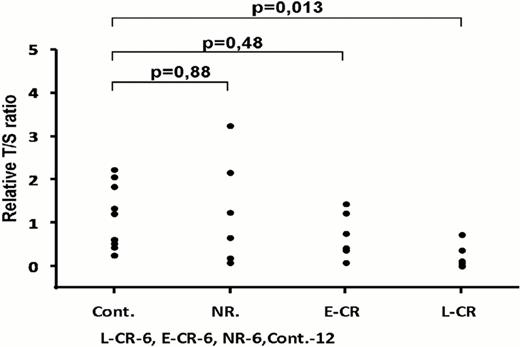Abstract
Abstract 4403
Severe aplastic anemia (SAA) is characterized by life-threatening cytopenias. SAA can be cured by hematopoietic stem cell transplantation, but in children when a sibling donor is unavailable, immunosuppressive therapy with antithymocyte globulin (ATG) plus cyclosporine is effective. Variations in telomere length have been reported in severe aplastic anemia but their clinical significance is not clear,
The aim of our study is relationship between telomere length and clinical response to immunosuppressive therapy children with severe aplastic anemia.
We measured telomere length in children with SAA at our institution who had received ATG plus cyclosporine between 2009 to 2011and analyzed its relationship with hematologic recovery. Patients 18 (9 girls and 9 boys) aged 7–19 yrs with SAA without sibling donor, have all received rabbit ATG in a dose of 3.75 mg/kg/day for 5 days and CSA in a dose of 5mg/kg/day for 12 months). Remission was assessed on 84th, 112th, 180th and 360th day of treatment. Patients were divided into 3 groups: I group: non responders NR, II group: early remission -ER (complete-CR and partial remission PR on 84th and 112th day), III late remission LR (CR and PR on 180th and 360th day). We analyzed telomere length in 20 parents (11 mothers and 9 fathers aged 39–55yrs) our 11 patients. Control peripheral blood samples were obtained from 12 healthy children (3 girls and 9 boys, aged 3–17 yrs), and 10 healthy adult (aged 28–55yrs). Informed consent was obtained from all adult donors and from parents of participating children.
Genomic DNA was extracted using AxyPrep Blood Genomic DNA Miniprep Kit (Axygene). Telomere length was measured using the quantitive PCR (qPCR) method described by Elisa Pavesi et al (1). Pavesi E. et al. Pediatr Blood Cancer. 2009;53(3):411-6. Two 96-well plates were prepared for measurements, first plate was used for amplification of telomere product and second one was used for single copy gene (SEP15) product amplification. Each reaction contained: Power SYBR1 Green PCR Master Mix (Applied Biosystems), DNA and primers (270nM Tel1 and 900nM Tel2 or 500nM each SEP15 primers). Reactions were preformed in Real Time PCR: CFX96 system (Biorad) with thermal cycling conditions: 95C–10 minutes; 95C–15 seconds, 54C 2 minutes (35 cycles).
Telomere/single copy gene (T/S) ratios for samples were calculated from Human reference DNA (Applied Biosystems) standard curve and T/S ratios values were expressed in relative to telomere length in controls. Statistica software version 9.0 (StatSoft, Tulsa, OK) was used for statistical analysis. Mann–Whitney U test was employed to compare telomere length among samples groups. p value <0.05 was considered statistically significant.
The telomere length in children with SAA were shorter than health children but this not significantly to (p=0, 16)
Twelve patients (66, 6%) responded to immunosuppressive therapy. There was correlation between telomere length and the late response. Children with late response were shorter telomere than children with control group (Fig 1).
Telomere length in health children and children with SAA according response to IST
We not noted in our patient relapse and clonally transformation, but time of observation was only 3 year
Parents children with SAA telomere length were shorter than health control adult people, but without significantly (p=0, 15) (Fig 2).
We found correlation between shorter telomere length parents and late response to immunosupression therapy in children with SAA (p= 0,012) (Fig 3).
Telomere length in health adult and parent's children with SAA according response of IST
Telomere length in health adult and parent's children with SAA according response of IST
Our observations indicate that SAA patients with shortened telomeres respond to immunosuppressive therapy better then those with elongated telomeres.
Telomere length parents of SAA children with response of IST were shorter than parent's in children with SAA without response.
Telomere length may be considered therefore as a predicting factor in these patients.
Studies on a larger group of patients should be performed to confirm our observations.
No relevant conflicts of interest to declare.
Author notes
Asterisk with author names denotes non-ASH members.




This feature is available to Subscribers Only
Sign In or Create an Account Close Modal